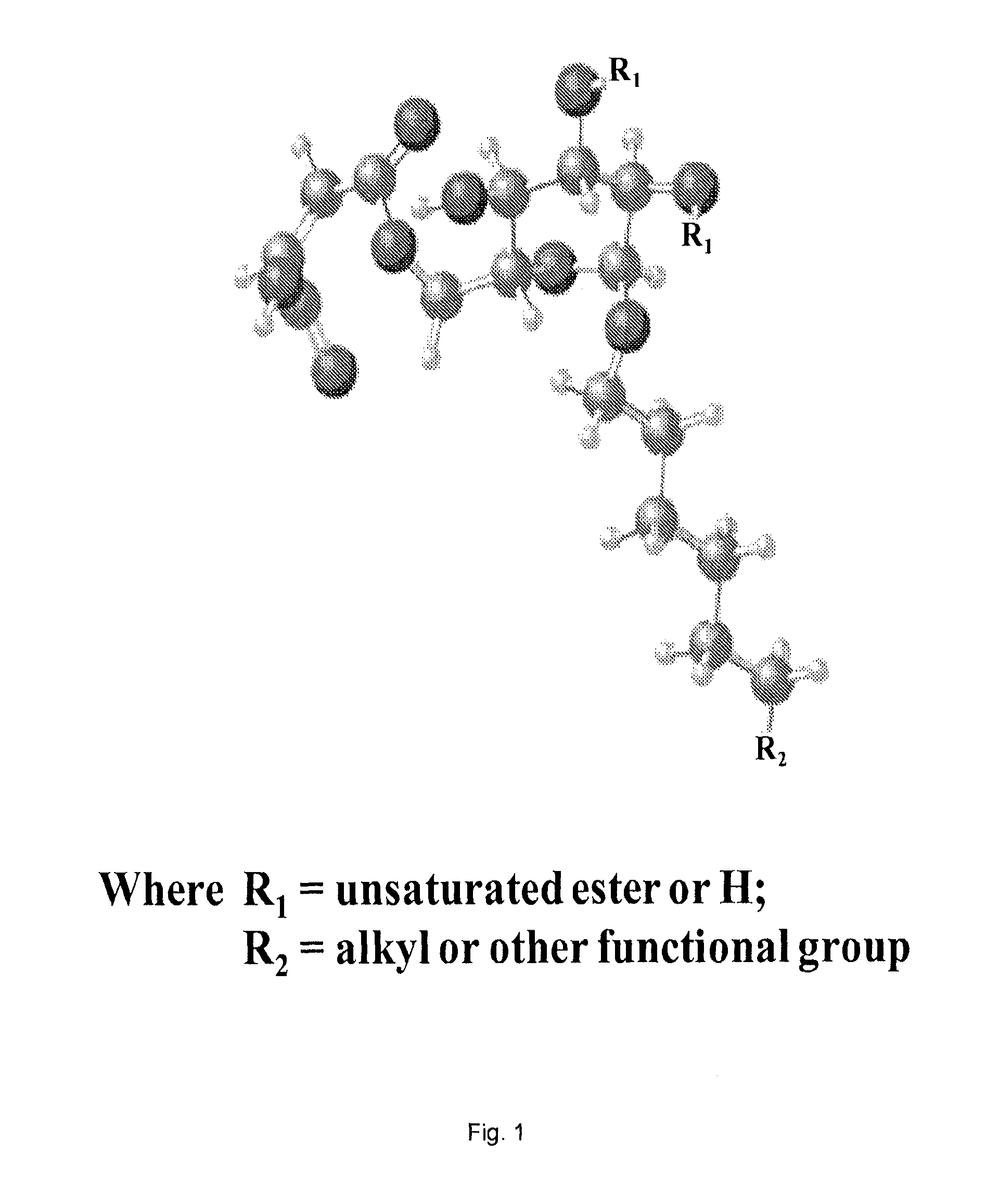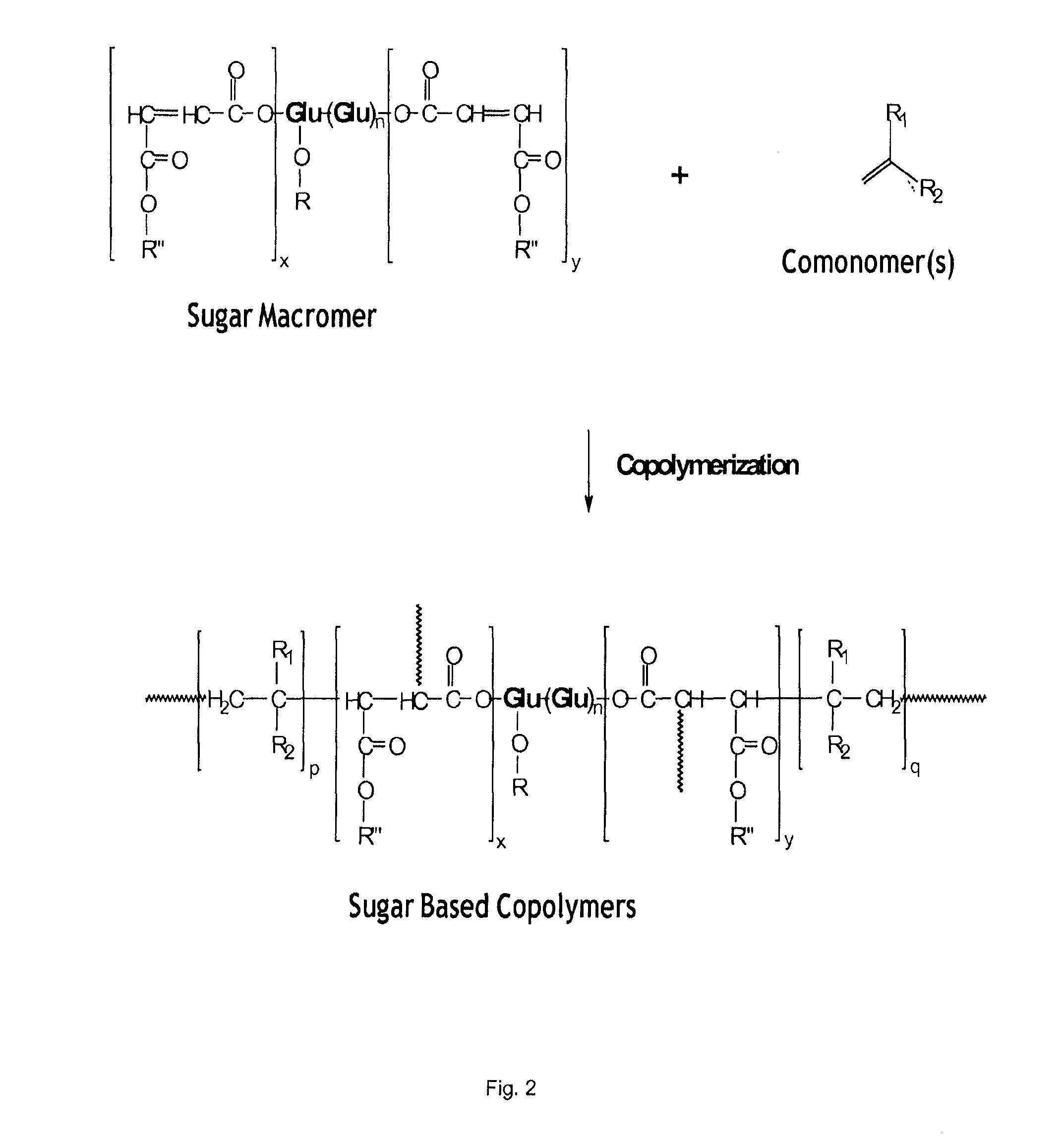Use of biobased sugar monomers in vinyl copolymers as latex binders and compositions based thereon
a technology of vinyl copolymer and composition, which is applied in the field of use of biobased sugar monomers in vinyl copolymer as latex binders and compositions based thereon, can solve the problems of increasing the re-use of contaminated wastepaper, the problem is even more severe for synthetic (petroleum based) latex products used in paper, adhesives, paper coating binders, etc., and achieves improved film forming and water retention, the effect of improving
- Summary
- Abstract
- Description
- Claims
- Application Information
AI Technical Summary
Benefits of technology
Problems solved by technology
Method used
Image
Examples
example 1
[0059]Free-radical emulsion or suspension copolymerizations are conducted with vinyl monomers and APG maleic acid ester monomers. The emulsion polymerizations are carried out in 1 liter, 4 necked, round bottom reaction kettles equipped with overhead mechanical stirrer, a condenser, a monomer pre-emulsion feed inlet, a thermocouple, an initiator solution feed, a nitrogen purge feed, and a nitrogen bubbler. The reaction vessel is charged with distilled water, stirred at 200 rpm, heated by using a water bath controlled at 80±1° C., and purged with nitrogen. Sodium carbonate buffer and ammonium persulfate initiator are dissolved in water and charged to the reactor immediately before the monomer addition is started. Examples of typical polymerization recipes are known to one of skill in the art.
[0060]Monomer pre-emulsions or suspensions are prepared as follows. An APG maleic acid ester monomer composition, for which the preparation is given in subsequent Examples, is added to conventiona...
example 2
[0061]A maleic acid ester of an APG is prepared as follows. To a 1 L erlenmeyer flask, containing a magnetic stir bar, 185.1 g anhydrous n-butanol (Aldrich, 99.8%), 36.1 g n-octanol (Aldrich, 99+%), and 2.0 g deionized water are added. To the stirred mixture, 0.184 g (100 mL) of concentrated sulfuric acid (J. T. Baker, 96.6%) is added using a 1 mL glass syringe. This mixture is added to a 500 mL three necked round bottom flask containing 50.0 g of anhydrous α-D-glucose (Aldrich, 96%) and a concave magnetic stir bar. The flask is fitted with a thermocouple probe, a dry air intake, and a 25 mL Barrett receiver on which two glass condensers are mounted, which are connected to a gas bubbler. The condensate collection side of the Barrett receiver is filled with n-heptane, and the gas flow-through side is wrapped in cotton wool for the purpose of insulation. Dry air, passed over a 10 inch column filled with dry molecular sieves and Drierite, is passed through the liquid phase in the round...
example 3
[0064]The procedure given in Example 2 is followed. The reaction time to form the APG is 3 hours, 20 minutes. The DPn of the APG is determined to be 1.67. Instead of 71.35 g maleic anhydride, 75.90 g is used, and 200.0 g of anhydrous n-butanol is used in the esterification step in place of n-hexanol; 0.75 g of the “TYZOR” TBT catalyst is used, and 89 g of dry basic alumina in place of molecular sieves. Excess butanol is removed using a rotary evaporator. Samples are taken for analysis by NMR and thin layer chromatography, which confirms the formation of APG, APG-maleic acid / octyl maleic acid mixture, and their partial esterification products. The pH of the APG-maleic acid / octyl maleic acid mixture is about 1.8, while the pH of the final product is about 2.6.
PUM
| Property | Measurement | Unit |
|---|---|---|
| Tg | aaaaa | aaaaa |
| Tg | aaaaa | aaaaa |
| Tg | aaaaa | aaaaa |
Abstract
Description
Claims
Application Information
 Login to View More
Login to View More - R&D
- Intellectual Property
- Life Sciences
- Materials
- Tech Scout
- Unparalleled Data Quality
- Higher Quality Content
- 60% Fewer Hallucinations
Browse by: Latest US Patents, China's latest patents, Technical Efficacy Thesaurus, Application Domain, Technology Topic, Popular Technical Reports.
© 2025 PatSnap. All rights reserved.Legal|Privacy policy|Modern Slavery Act Transparency Statement|Sitemap|About US| Contact US: help@patsnap.com



